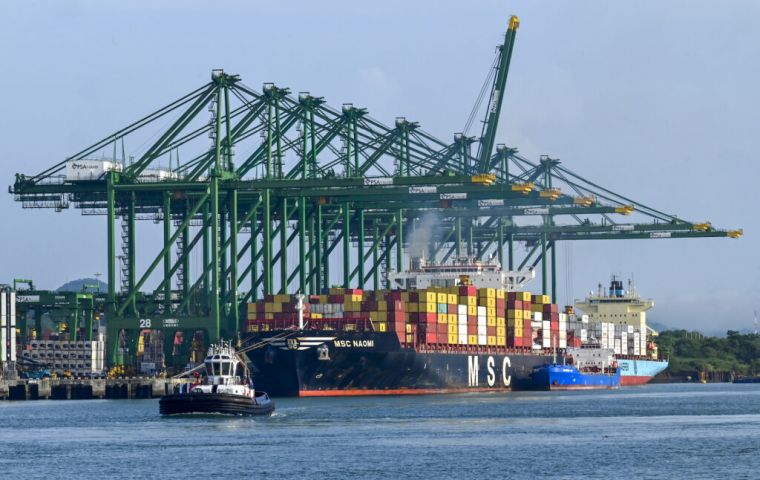MercoPress. South Atlantic News Agency
Fears of illegal goods trading as China’s takes control of Latin American ports along the Pacific
 Containerized seaborne trade accounts for 90% of global trade, with over 500 million units shipped each year, but UNODC says fewer than 2% of shipments are inspected
Containerized seaborne trade accounts for 90% of global trade, with over 500 million units shipped each year, but UNODC says fewer than 2% of shipments are inspected A report by the Washington-based think tank, the Center for Strategic and International Studies (CSIS) indicates strong concern with the increasing number of Chinese-operated ports in Latin America, fearing an increase in criminal networks and the trafficking of illicit goods and smuggling.
“Geopolitically, the network of ports and maritime routes controlled by Chinese companies strategically covers the Latin American Pacific connecting critical areas both for the arrival of chemical precursors for drug production and the departure of illegal goods, wildlife trafficking, illegal mining, and exploitation of natural resources,” said Yadira Gálvez, a security expert and academic at the National Autonomous University of Mexico. “This creates significant instability and concern in the region.”
According to CSIS, TCOs use ports to conceal illegal products within legal shipments, a tactic made easier by the expansion of global markets. Trade agreements between China and the region have created a network that moves large volumes of legal goods, facilitating the transit of goods in both directions.
Containerized seaborne trade accounts for about 90% of global trade, with over 500 million units shipped each year. However, according to the United Nations Office on Drugs and Crime (UNODC), because fewer than 2 percent of these shipments are inspected, ports become crucial points for illicit trafficking.
China owns or controls several ports in Latin America and the Caribbean, including Lázaro Cárdenas and Manzanillo in Mexico, Balboa and Colón in Panama, and a terminal in Buenos Aires. COSCO Shipping Ports Ltd., a subsidiary of the Chinese state-owned conglomerate COSCO, controls 60% of the recently inaugurated Port of Chancay in Peru.
In November, COSCO began weekly container shipments from Chancay to Asia, with a direct route to Shanghai and other destinations that will vary based on demand, as the Mexican daily El Economist reported. It will also open cabotage routes with ships from Colombia, Ecuador, and Chile, consolidating its cargoes in Chancay.
A report titled ‘Organized Crime Trends and Alerts 2024’, by the Peru-based Institute of Criminology and Violence Studies, warns that Chancay could become a hub for cocaine and fentanyl trafficking between South America and Asia.
CSIS notes that Chinese investment in Latin America’s infrastructure fosters an environment of opacity, limiting transparency and accountability, which facilitates the corruption and bribery necessary for criminal organizations to exploit ports; this is even easier when a port has a vertical operating structure, as seen in Chancay, where COSCO controls all port functions.
“This represents a major vulnerability for countries in the region. An example is the Chinese base in Argentina, which operates with high levels of secrecy, to the point that even the Argentine government is unsure of the activities there,” Gálvez said. “This lack of transparency could be replicated in Chinese-run ports across Latin America.”
According to CSIS, in 2023, at least 75 foreign vessels, mostly Chinese, entered Peruvian ports without the required satellite tracking device, as mandated by Peruvian law. These ships arrived at the ports of Paita, Chimbote, Callao, and Paracas, where COSCO operates.
In Mexico, the Port of Lázaro Cárdenas, located in Michoacán, is strategic for organized crime. According to the DEA’s ‘National Drug Threat Assessment 2024’ report, the Jalisco New Generation Cartel (CJNG) uses Lázaro Cárdenas for drug trafficking, although it also operates in the Port of Manzanillo in Colima.
The CJNG employs bribery, intimidation, and extortion to ensure the passage of its shipments, which include cocaine from Colombia, Peru, and Bolivia, as well as precursor chemicals from China for the production of fentanyl and methamphetamines. These ports play a key role in receiving these chemicals from China on a large scale, according to the DEA.
The DEA report also notes that the Sinaloa Cartel operates in at least 47 countries, including China, where it obtains precursor chemicals for drugs, traffics methamphetamine, and has ties to Chinese money laundering networks. Precursor chemicals for fentanyl are smuggled into Mexico, hidden in legal shipments passing through Pacific ports.
China tends to downplay the severity of fentanyl trafficking, often blaming third parties, as reported by ‘Otros Diálogos’ magazine of the College of Mexico. Another concern is the rising number of Chinese migrants entering Mexico illegally through Pacific ports, where Chinese criminal groups are involved in human trafficking and totoaba fish trafficking. The totoaba, endemic to the Gulf of California and endangered, is prized in China for its swim bladder, which is used in soup and traditional medicine.
“China is intensifying its presence in Latin America, not only with its logistics network but also by offering port technology at affordable prices, even on credit,” pointed out Galvez. “This growing influence raises concerns about information security, as this equipment could be used to collect sensitive data in strategic areas such as customs.”




Top Comments
Disclaimer & comment rulesCommenting for this story is now closed.
If you have a Facebook account, become a fan and comment on our Facebook Page!